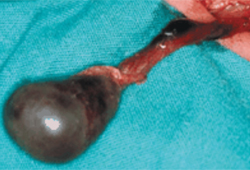Case history
Case history
A 13-year-old boy developed sudden-onset unilateral scrotal pain that awoke him from sleep. He presents with left scrotal pain, nausea and vomiting, and left lower abdominal pain. On exam, he has a tender, enlarged, high-riding left testicle with a transverse lie. There is an absent cremasteric reflex on the left.
Other presentations
Neonatal cases of testicular torsion may present with scrotal swelling and discoloration similar to that seen in cases of scrotal hematoma.[3][4][Figure caption and citation for the preceding image starts]: Intraoperative photograph showing extravaginal torsion of the spermatic cord and the necrotic testis in a newborn with discoloration of the right testicle at birthAso C, et al. RadioGraphics. 2005;25:1197-1214. Used with permission [Citation ends]. [Figure caption and citation for the preceding image starts]: Longitudinal ultrasound scan in a newborn with discoloration of the right testicle at birth showing the testis (T) surrounded by a highly echogenic tunica (arrows), which is probably calcified; a complex hydrocele (h) with several septa occupies the scrotal sacAso C, et al. RadioGraphics. 2005;25:1197-1214. Used with permission [Citation ends].
[Figure caption and citation for the preceding image starts]: Longitudinal ultrasound scan in a newborn with discoloration of the right testicle at birth showing the testis (T) surrounded by a highly echogenic tunica (arrows), which is probably calcified; a complex hydrocele (h) with several septa occupies the scrotal sacAso C, et al. RadioGraphics. 2005;25:1197-1214. Used with permission [Citation ends].
Patients with testicular appendix torsion tend to be younger (typically between ages 7 and 12 years), and their unilateral scrotal pain is usually more gradual in onset and not associated with symptoms such as nausea and vomiting.[5][6] On physical exam, the nontender testicle has a normal lie with a tender nodule superiorly that appears as a "blue dot sign" in up to 52% of patients when illuminated posteriorly.[7]
Use of this content is subject to our disclaimer